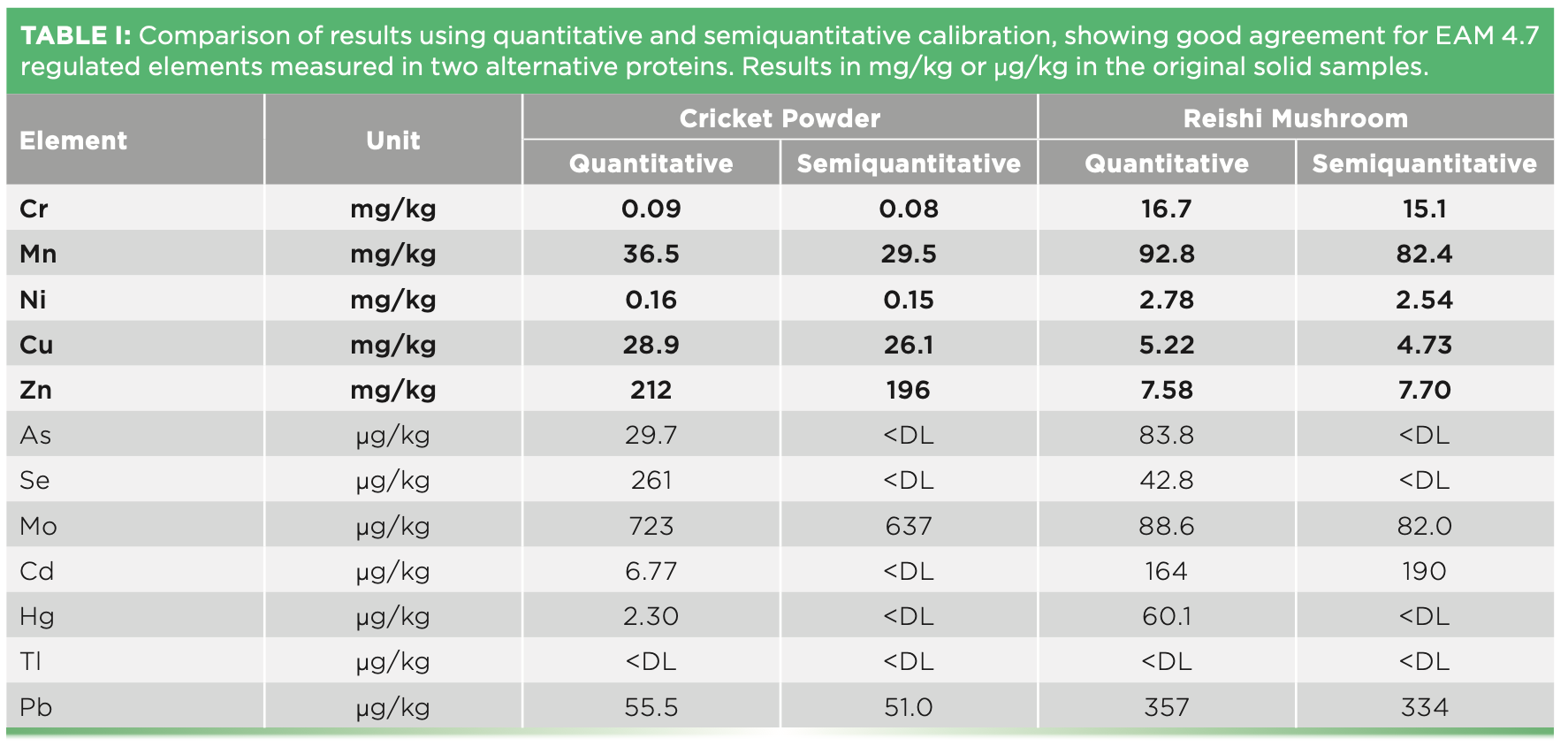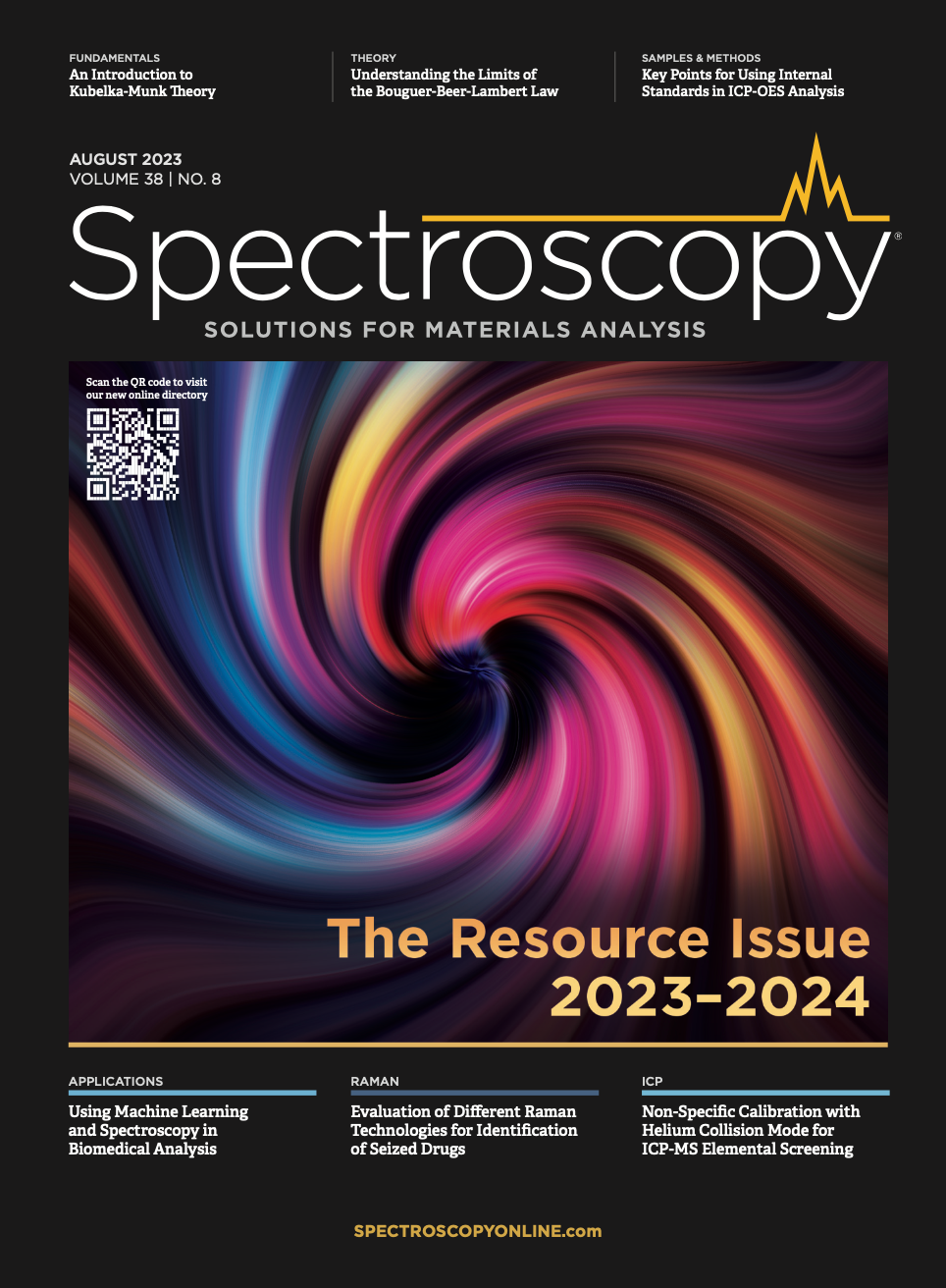Non-Specific Calibration Combined with Helium Collision Mode for Elemental Screening
Elemental analysis labs often measure only a small number of elements; for example, the U.S. Food and Drug Administration (FDA) Elemental Analysis Manual (EAM) regulatory method for food analysis by inductively coupled plasma-mass spectrometry (ICP-MS) (EAM 4.7) specifies only 12 trace elements. ICP-MS is a fast, multielement technique that can measure nearly every element in the periodic table and cover a concentration range from ultratrace to major elements. While labs rarely need to quantify all 75 or so elements that ICP-MS can measure, they may benefit from acquiring a more complete picture of the total elemental content of each sample. The amount of useful information that can be extracted from the ICP-MS mass spectrum is dramatically increased when helium (He) collision mode is used to minimize common spectral overlaps. Some ICP-MS instruments can perform a fast, He mode screening acquisition for each sample, combined with non-specific calibration to give semiquantitative concentrations for “all elements”. He mode screening gives access to confirmatory isotopes and detects elements that were not included in the quantitative analysis, providing valuable additional insight into each sample’s composition.
Inductively coupled plasma mass spectrometry (ICP-MS) can measure almost the entire elemental mass spectrum from below mass 6 (Li) to beyond mass 238 (U), covering nearly every isotope of all the naturally occurring elements, plus many radiogenic isotopes. Every natural element except indium (In) has at least one isotope that is free from direct overlap by an isotope of another element. The most abundant of these “free” isotopes is usually predefined as the preferred isotope in ICP-MS methods, so many analysts simply measure the preferred isotope of each target analyte and skip the rest of the mass spectrum—so-called peak jumping or peak hopping.
In some cases, the most abundant isotope is not the best option for measurement, due to the potential for spectral overlap from a molecular or “polyatomic” ion. Polyatomic ions are formed from combinations of elements present in the sample and gases, such as argon (Ar), oxygen (O), nitrogen (N), hydrogen (H), and carbon (C). ICP-MS methods usually take account of some of the most predictable of these polyatomic ions, so iron (Fe) may be measured at its minor isotope, Fe-57, to avoid the expected overlap from 40Ar16O+ at mass 56, for example. But many interfering polyatomic ions are formed from components of the sample matrix, so the interferences vary by sample type and cannot easily be predicted or avoided. For instance, a carbon matrix would be expected to cause an 40Ar12C+ polyatomic ion overlap on Cr-52, so the Cr-53 isotope is often defined as the preferred isotope in ICP-MS methods, despite it being almost 10 times less abundant than Cr-52. But, in a chloride matrix, a 37Cl16O+ polyatomic ion can affect the Cr-53 isotope, causing errors. In a sample that contains both carbon and chloride, analysts must choose which (if any) isotope is giving accurate results. This dilemma applies to many elements, particularly those with isotopes between mass 45 and 85, a mass region that is particularly prone to matrix-derived polyatomic ion overlaps.
Screening in Helium Collision Mode
The development of collision-reaction cells (CRC) that operate effectively in He mode provided ICP-MS users with a dependable way to reduce the impact of polyatomic ion overlaps in typical sample matrices (1). He mode reduces all polyatomic ion overlaps, so, as well as transforming the accuracy and reliability of ICP-MS measurements using preferred isotopes, it also makes additional isotopes available for many analytes (2). These additional, secondary isotopes can be used as “qualifiers” to confirm the result measured at the primary isotope. The universality of He mode means that the same cell conditions can be used for nearly all the isotopes of almost every element typically measured by ICP-MS.
It is not usually practical to use long integration times (for example, 1 second per mass, as might be used for a quantitative analysis) for all isotopes of all elements. But some ICP-MS instruments offer a “QuickScan” screening mode that collects data for all masses using a very short integration time per mass, taking only a couple of seconds additional acquisition time per sample. QuickScan combined with He collision mode provides an overview of the elemental composition of each sample, practically free from polyatomic ion overlaps.
ICP-MS laboratories, especially those that measure unknown and variable samples, can benefit from using He mode screening to access more of the information available in the mass spectrum. The QuickScan spectrum can be used to identify non-target elements, such as unexpected contaminants and matrix components. Analysts can verify their quantitative data by comparing the result from a secondary, qualifier isotope and confirm the presence (or absence) of spectral overlaps.
Non-Specific, Semiquantitative Calibration in ICP-MS
Normal external calibration methods use standards with known concentrations for each target element. The counts for the analytes in the unknown samples are compared against the calibration plot to calculate quantitative concentrations. With non-specific calibration, a mass/response curve is generated, based on the measured response for a few elements across the mass range. Elements that are not present in the standards are calibrated by interpolation between these reference masses. The semiquant calibration can be improved by including more elements in the semi-quant standard, and accuracy is also affected by several other factors:
- All elements should be free from significant spectral (polyatomic ion) overlap.
- All isotopes must be measured under the same tuning conditions.
- The mass response should have minimal mass bias (the difference in transmission for low-, mid-, and high-mass elements).
The first two requirements are addressed by He collision mode, while the third is mainly controlled by the design of the ICP-MS interface and ion lens. Figure 1 illustrates the relatively uniform mass response curve of the Agilent ICP-MS, showing mass bias of less than a factor of 4 across the mass range. Mass bias does increase in He mode, however, due to low-mass scattering. The combination of He collision mode and minimal instrument mass bias can provide surprisingly accurate results without element-specific calibration. This is illustrated by the comparison of quantitative and semiquantitative results for the EAM 4.7 elements in two alternative protein samples, cricket powder and Reishi mushroom, shown in Table I. The percentage difference between the element-specific, externally calibrated, quantitative results and the non-specific, semiquantitative results were mostly less than +/- 10% and all were within +/- 20%. Note that the very short integration time used for QuickScan means that detection limits (DLs) are poorer than with the longer integration times used for normal quantitative analysis.
FIGURE 1: Mass response curve from an Agilent single quadrupole ICP-MS. Measured signals have been corrected for isotopic abundance and degree of ionization calculated using a plasma temperature of 7400 K.


QuickScan Mass Spectrum and Isotopic Abundance Templates
The ability of He mode QuickScan to extend the ICP-MS analysis to provide “all element” screenings of the two alternative protein samples is illustrated in Figure 2. Using He collision mode means the measured mass spectrum is very simple, as it is essentially free from common polyatomic ion overlaps. This allows analysts to confirm the presence of elements and matrix components by comparing the measured spectrum against the built-in natural isotopic abundance templates. The measured peaks in Figure 2 match the templates, confirming the presence of several elements that were determined quantitatively, such as copper (Cu) and zinc (Zn) in cricket powder, and chromium (Cr), manganese (Mn), and Fe in Reishi mushroom (Table I). But QuickScan measures all masses, so other elements that were not part of the quantitative method are also accessible. For example, it is apparent that the two samples contained very different levels of sodium (Na), magnesium (Mg), phosphorus (P), rubidium (Rb), and barium (Ba), elements that are not listed in the FDA EAM method. The isotope templates update automatically as the operator scrolls through the sample list, so analysts can quickly review the additional “all-element” data for the sample batch. As a further aid to data interpretation, a color-coded periodic table “heat map” may be available to provide a visual display of the relative levels of each element in each sample (3).
FIGURE 2: Full mass spectra with natural isotopic abundance templates high- lighting differences in elemental content of two alternative protein samples, (a) cricket powder, and (b) Reishi mushroom. All measured peaks match the theoretical isotope abundance templates, confirming He mode successfully removed all potential matrix-based polyatomic ions. Sc, Ge, Rh, In, Tb, Lu, Ir, and Bi were added as internal standard elements. Axis labels are Mass for x-axis and Counts per Second (CPS) for y-axis.

Summary
In many ICP–MS applications, analysts only use a small fraction of the information available for each sample. The ICP–MS mass spectrum contains useful additional information that can easily be collected using a quick, full mass range “screening” scan in He collision mode. QuickScan adds only a couple of seconds measurement time per sample but collects data for almost every isotope of nearly all elements.
Semiquantitative concentrations, often accurate to within +/- 20%, can be calculated for “all elements” based on the instrument’s mass/response curve. Analysts can quickly review and compare results using visual display tools such as isotopic templates and color-coding that highlights different concentration levels.
References
(1) Yamada, N.; Takahashi, J.; Sakata, K. J. Anal. At. Spectrom. 2002, 17, 1213-1222. DOI: 10.1039/B205416G
(2) McCurdy, E.; Woods, G. J. Anal. At. Spectrom. 2002, 19, 607–615. DOI: 10.1039/B312250F
(3) Nelson, J.; Hasty, E.; Anderson, L.; Harris, M. “Determination of Critical Elements in Foods in Accordance with US FDA EAM 4.7 ICP-MS Method”, Agilent Publication 5994-2839EN, 2021.
Ed McCurdy and Peter Riles are with Agilent Technologies, Inc. Direct correspondence to: ed_mccurdy@agilent.com ●

Newsletter
Get essential updates on the latest spectroscopy technologies, regulatory standards, and best practices—subscribe today to Spectroscopy.
Mediterranean Origins of Red Coral Artifacts in Xinjiang Reveal Ancient Silk Road Trade Links
June 26th 2025A new study published in Minerals reveals that red coral artifacts unearthed in Xinjiang’s Shengjindian cemetery originated from the western Mediterranean, highlighting early Silk Road trade and long-distance cultural exchange during the Han Dynasty.
How Do We Improve Elemental Impurity Analysis in Pharmaceutical Quality Control?
May 16th 2025In this final part of our conversation with Harrington and Seibert, they discuss the main challenges that they encountered in their study and how we can improve elemental impurity analysis in pharmaceutical quality control.
High-Speed Laser MS for Precise, Prep-Free Environmental Particle Tracking
April 21st 2025Scientists at Oak Ridge National Laboratory have demonstrated that a fast, laser-based mass spectrometry method—LA-ICP-TOF-MS—can accurately detect and identify airborne environmental particles, including toxic metal particles like ruthenium, without the need for complex sample preparation. The work offers a breakthrough in rapid, high-resolution analysis of environmental pollutants.